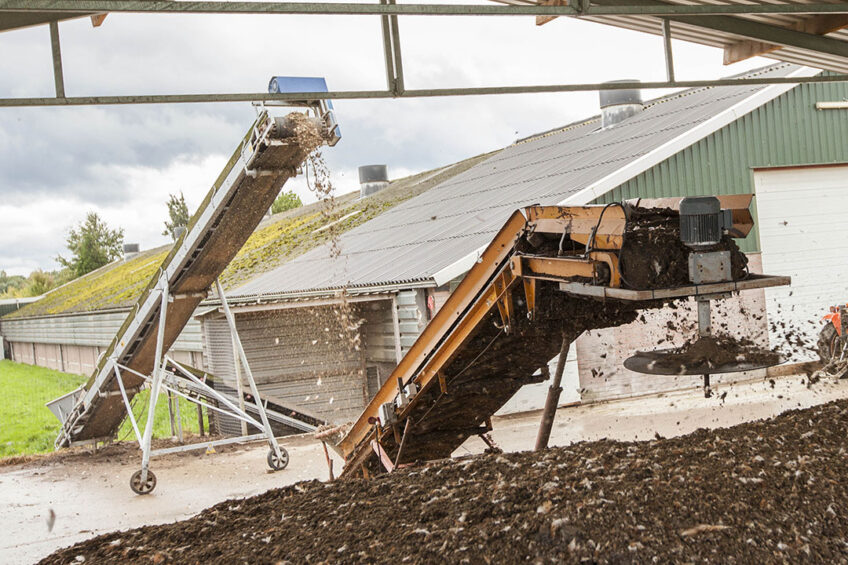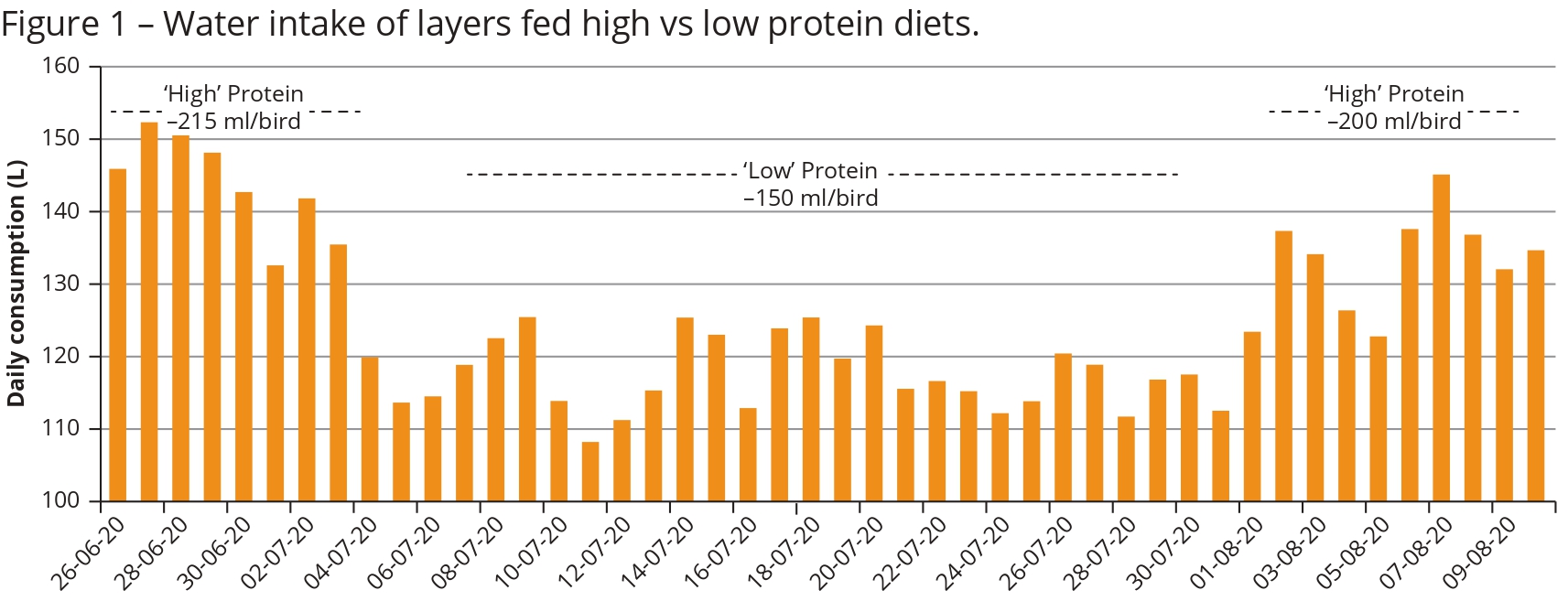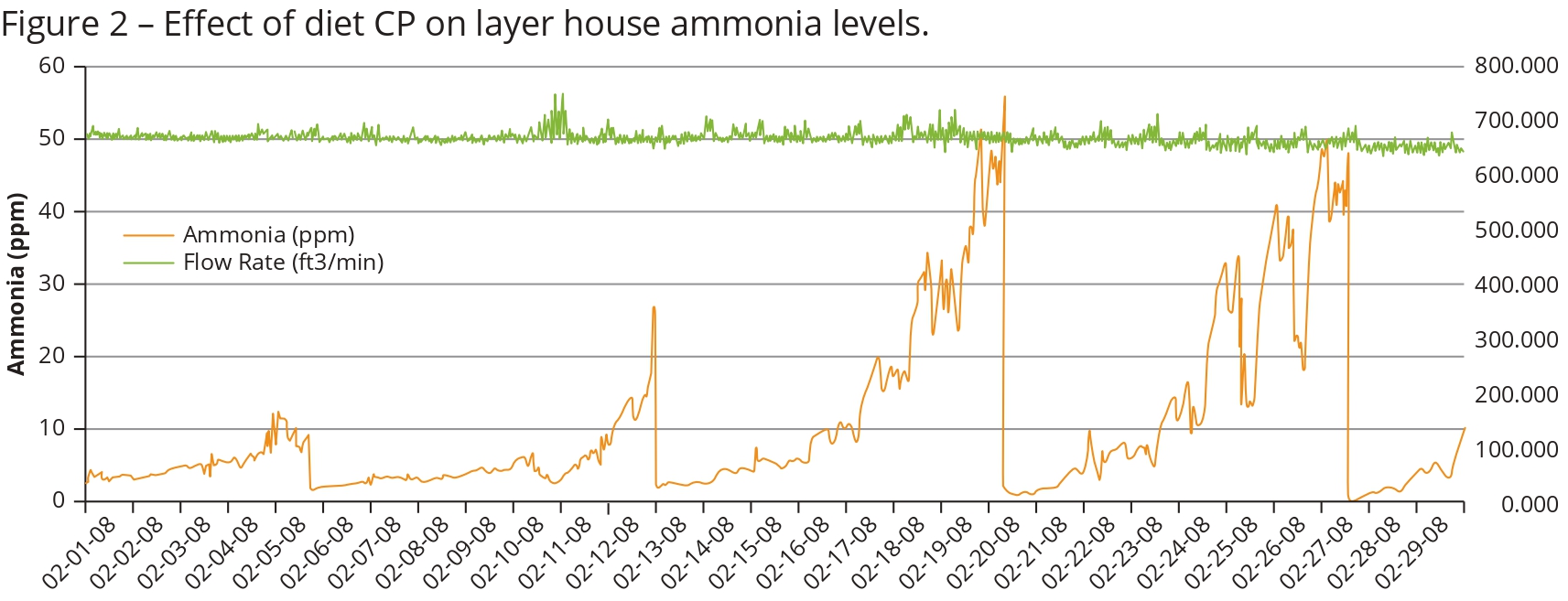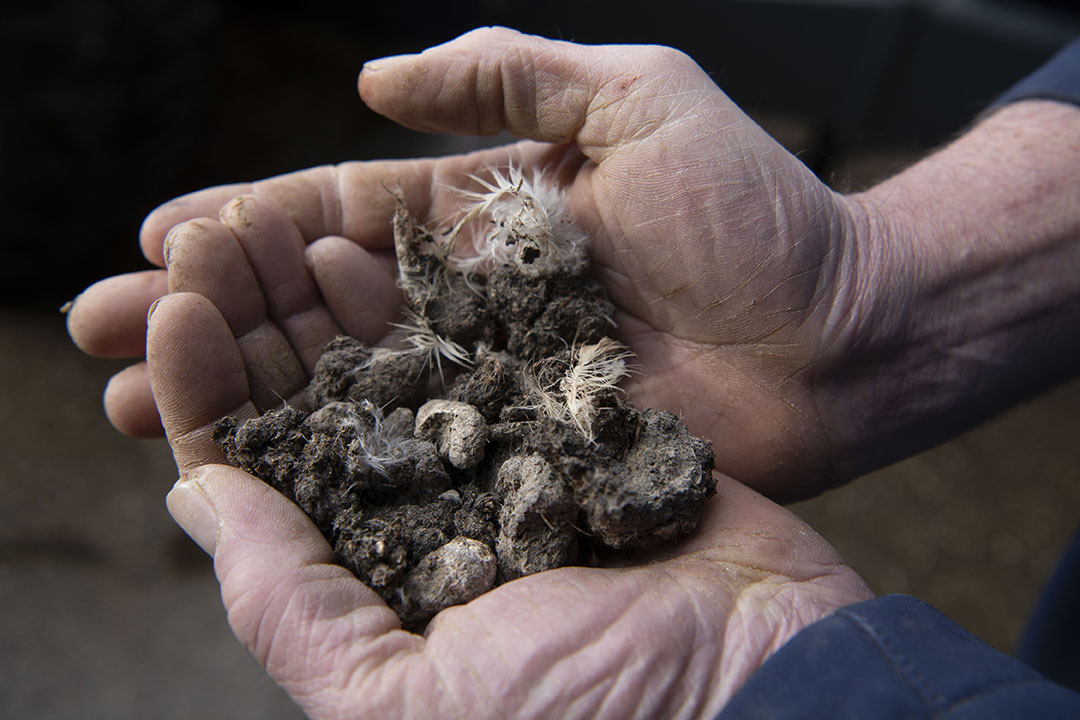Impact of layer diet formulation on manure composition

The daily manure production of a laying hen is roughly equal to its feed intake at around 100g, as birds digest about 80% of feed dry matter, and fresh manure is initially close to 20% dry matter. Diet composition and its effect on water intake impact manure quality, its handling characteristics, environmental load and value.
Manure can be a valuable commodity as a fertiliser for arable land, although there is often an imbalance in manure volume generated from large farms compared to the local land base of such farms. One environmental issue is, therefore, the responsible application of layer manure to meet yearly crop yields. In this regard, our focus is on the nitrogen and phosphorus content of manure.
The handling characteristics of manure are mainly influenced by its moisture content and/or the ability of manure to “adsorb” moisture. The birds’ water intake directly influences manure moisture, and this can be greatly influenced by diet composition. Within controlled environment layer houses, there is the added concern about ammonia release from manure that accumulates even just over a 7-day period between mechanical clean-outs. Manure consistency is a practical management concern in open-sided layer houses, as is the impact that manure moisture has on fly populations.
Nitrogen
Table 1 shows calculations for the yearly output of manure phosphorus and nitrogen based on a range of diet nutrient levels and as impacted by feed intake. The values for nitrogen are quite easy to predict since there is an almost constant relationship between diet CP and its digestibility. The almost 50% increase in diet CP from 14-20% is mirrored in the same 50% increase in manure nitrogen output calculated at any given feed intake.
Comparable calculations for phosphorus balance are perhaps more subject to contention. Phytase enzyme is almost universally used in layer diets where it ‘releases’ some 0.12% of phosphorus from plant-based phytic acid. These calculations assume such a single-dose use of phytase.
What has not been included in the calculations in Table 1 is the variable ‘availability’ of phosphorus dependent on diet supply. In this regard, the percentage of phosphorous digestibility/availability is increased when feeding low levels rather than high levels of phosphorus. For this reason, the calculations of the output of phosphorus shown are probably underestimates at the higher levels of diet inclusion and overestimates at lower diet inclusion levels.
Land base
Table 2 shows the land base required for the responsible application of layer manure for growing either corn or wheat. These calculations assume that these crops require 170kg N/hectare and 35kg P/hectare (70kg P2O5/hectare). The main limitation of manure application is the nitrogen content of manure, the responsible application of which requires almost twice as much land as does responsible disposal of the phosphorous in the same manure.
While most regulatory agencies are focused on N and P land disposal, there is concern about some trace minerals, especially zinc. Virtually 90% of zinc in feed is deposited in manure, so balance and excretion rates are easily calculated. Each year, these 10,000 layers produce manure that contains about 50kg of elemental zinc, or about 1kg/hectare, as dictated by the land base for use for nitrogen application. This application is much less than the 2-4kg Zn/hectare commonly applied to increase corn yield.
Manure consistency
Although there are no other real issues regarding the phosphorus loading of manure, the level of protein and nitrogen in feed can have major effects on manure consistency since diet CP directly influences a layer’s water intake.
Figure 1 shows how feeding a high vs low protein layer diet affects the bird’s water intake. In this study, the high-protein diet was formulated to around 19%, while the low-protein diet (with the same level of amino acids) was formulated to a maximum of 15%. When fed the high protein diet, the layers initially drank around 215ml water/bird/day. After 7 days, the birds were suddenly changed to the low-protein diet, and water intake immediately declined to 150ml/bird/day and remained at this level until some 28 days later when the high-protein diet was reintroduced when water intake immediately increased to 205ml/bid/day. This quite dramatic picture of water intake shows the potential for manipulating diet CP as a means of water conservation and the added benefit of dryer manure from birds fed less protein.

Ammonia release
In controlled environment layer houses, diet CP/N also impacts the potential for ammonia release from manure. About 50% of the nitrogen in layer manure is in the form of uric acid. This nitrogenous source can be converted to ammonia via the action of bacterial uricase and urease enzymes. The degree of ammonia release is increased at higher temperatures and with an adequate supply of water and oxygen and is most prevalent when manure is alkaline.
Figure 2 shows the cyclic pattern of ammonia build-up in a controlled environment research facility equipped with continuous monitoring for in-house ammonia levels. Standard management practice was belt clean-out of manure on a weekly basis. At the start of the study, layers were fed a 15% CP diet. Over the first 7 days of the study, ammonia level increased to 10ppm, and then to almost zero following weekly manure removal. This pattern was repeated in the second week. At that time, the diet was changed to 20% CP (same amino acids and all other nutrients).

Over the next week, the ammonia level increased to just over 50ppm, then to zero following clean-out and returned to 50ppm ammonia over the next 7 days. The ventilation rate was intentionally unchanged across the 1-month study. This data clearly shows the impact of layer diet CP on ammonia production, and without a change in ventilation rate, the levels of ammonia achieved are problematic for both layers and farm staff.
Electrolytes
The other major dietary component impacting manure composition is the level and balance of various electrolytes. As we increase diet sodium, potassium, chloride, and sulphate, layers will drink more water. In most production situations, electrolyte levels are kept to a minimum so as to limit water intake. Only in situations of heat distress is this a questionable management practice since stimulating water intake is critical where there is potential for heat stress mortality and where manure moisture content must assume secondary consideration.

Most of the dietary potassium originates in soybean meal, while most sodium comes from additives such as salt and sodium bicarbonate. The anions also come from salt, together with other supplements that can be high in either chloride or sulphate – the latter assuming importance if one considers that sulphate was a component of Mongins’ original equation, being subsequently dismissed due to low dietary inclusions used at that time.
Drinking water can also be a significant contributor to intakes of sodium, chloride, and sulphates. Table 3 outlines the effect of graded and very high sodium and potassium levels on water intake and manure moisture. As expected, the effects of graded sodium and potassium levels are very similar, where, on average, water intake increases by about 1.3% per 0.01% increase in either cation. Likewise, these same increments of either sodium or potassium increase manure moisture by about 1%.
When salt is added to layer diets, sodium is often assumed to be the main factor affecting water consumption and so wetter manure. In reality, the chloride ion has a major impact on water intake, and hence one of the reasons behind replacing salt with sodium bicarbonate in layer diets (Table 4).
Two other dietary factors that impact manure moisture, or at least manure handling characteristics, are diet pelleting and fibre composition. It is generally recognised that optimum layer performance is seen when using pelleted diets, ostensibly due to the limited segregation of ingredients and nutrients. However, pelleting per se (vs mash diets) invariably results in wetter manure, the exact cause of which has never been adequately resolved.
Effect of fibre
There is surprisingly little information on the effect of dietary fibre on layer manure characteristics. While it is generally recognised that adding fibre ‘improves’ manure handling characteristics, little research supports such anecdotal assumptions. Regardless, adding 1-2% insoluble fibre is a very common practice aimed at improving the physical appearance of manure and its handling characteristics.
While NSPs have long been known to cause viscous manure, it’s only recently that the addition of insoluble fibre has been considered. Certain fibres are thought to imbibe water, which is more commonly referred to as ‘water binding capacity’. Cellulose and hemicellulose have relatively high water binding capacity, while that of lignin is minimal. Interestingly pectin has perhaps the best water-binding capacity of any fibre, but unfortunately, this occurs at acidic pH and so can hinder hind-gut activity. It appears smaller particles of fibre (0.15mm vs 0.4mm) have better water binding capacity mainly due to there being increased physical surface area for water capture. Such binding of water impacts manure consistency, usually without affecting manure moisture content.
The ingredient and nutrient composition of layer diets can impact the nutrient and physical characteristics of layer manure. The nitrogen and phosphorus content of diets directly influences the deposition of these nutrients in manure. Using less crude protein together with phytase and protease enzymes gives us options for increasing environmentally-acceptable manure application rates and the potential for reducing ammonia release.
A very practical concern about layer manure on commercial farms is its moisture content, especially within open-sided housing systems. Manure moisture is a factor in the birds’ water intake, and as such higher levels of protein and both anions and cations encourage water intake of high-producing layers. Judicious use of insoluble fibre, on the other hand, can improve the physical appearance of manure and so its handling characteristics.












